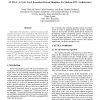Free Online Productivity Tools
i2Speak
i2Symbol
i2OCR
iTex2Img
iWeb2Print
iWeb2Shot
i2Type
iPdf2Split
iPdf2Merge
i2Bopomofo
i2Arabic
i2Style
i2Image
i2PDF
iLatex2Rtf
Sci2ools
ISPASS
2006
IEEE
2006
IEEE
ATTILA: a cycle-level execution-driven simulator for modern GPU architectures
The present work presents a cycle-level execution-driven simulator for modern GPU architectures. We discuss the simulation model used for our GPU simulator, based in the concept of boxes and signals, and the relation between the timing simulator and the functional emulator. The simulation model we use helps to increase the accuracy and reduce the number of errors in the timing simulator while allowing for an easy extensibility of the simulated GPU architecture. We also introduce the OpenGL framework used to feed the simulator with traces from real applications (UT2004, Doom3) and a performance debugging tool (Signal Trace Visualizer). The presented ATTILA simulator supports the simulation of a whole range of GPU configurations and architectures, from the embedded segment to the high end PC segment, supporting both the unified and non unified shader architectural models.
| Added | 12 Jun 2010 |
| Updated | 12 Jun 2010 |
| Type | Conference |
| Year | 2006 |
| Where | ISPASS |
| Authors | Victor Moya Del Barrio, Carlos González, Jordi Roca, Agustin Fernández, Roger Espasa |
Comments (0)

